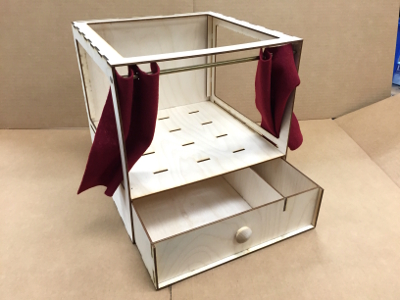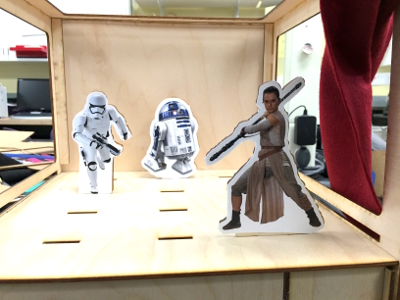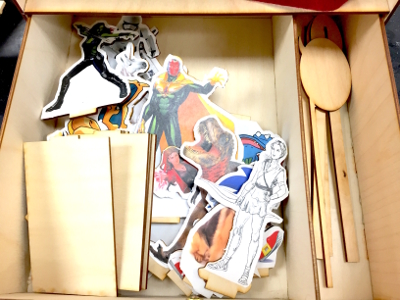Projects
These are education-related projects I worked on at Stanford.
Math Caper (completed prototype)
Math Caper is a computer game that bridges the gap between school math and real life. Typical word problems are unrealistic and encourage students to learn special "math class rules" for solving them. There is little transfer between these problems and encounters with mathematical situations in the real world. Math Caper presents kid-friendly crime stories that can only be solved by realistic problem solving and the thoughtful application of math skills. Let's stop teaching kids to solve math problems, and start teaching them to solve problems with math. Math Caper is my LDT master's project. I programmed it in Processing, based on Java. Game art by Rachel Jane Andelman and John Flanagan, music by Jon Fuller.
Download Math Caper (Windows 64-bit)
Math Caper by Marc Campasano is licensed under a Creative Commons Attribution-NonCommercial-NoDerivatives 4.0 International License.
Read report -- contains game solution!
Watch video
Watch presentation
Read about Math Caper and LDT on EdSurge
Download Math Caper (Windows 64-bit)

Math Caper by Marc Campasano is licensed under a Creative Commons Attribution-NonCommercial-NoDerivatives 4.0 International License.
Read report -- contains game solution!
Watch video
Watch presentation
Read about Math Caper and LDT on EdSurge
AirScope (completed prototype)
AirScope is a software tool that visualizes the air around us. The app uses weather data from the Internet or the user's own sensors to create a visual simulation of air particles in the area. AirScope is intended to help young children better understand what air is without requiring high school chemistry or physics. The simulation can be used to learn about temperature, wind, humidity, climate, climate change, and many other related topics. I designed and programmed AirScope (in Processing, based on Java) for the Beyond Bits and Atoms course. For further information read the document below.
Download AirScope demo (Windows 64-bit)
AirScope by Marc Campasano is licensed under a Creative Commons Attribution-NonCommercial-NoDerivatives 4.0 International License.
Watch demonstration
Read documentation
Download AirScope demo (Windows 64-bit)

AirScope by Marc Campasano is licensed under a Creative Commons Attribution-NonCommercial-NoDerivatives 4.0 International License.
Watch demonstration
Read documentation
Puppet Theater (completed toy)
This is a puppet theater designed for two specific children. My partner and I observed a brother and sister who enjoyed drawing comics and filming movies with their toys. In order to encourage these interests, we made this theater, which allows them to insert their own scenery drawn on a standard, letter-size piece of paper. Special notches in the floor of the theater can hold puppets which we made for them based on their interests and favorite characters. It also comes with speech bubble props for comics-style scenes, puppet-holding handles for control from a distance, blank puppets for the kids to draw their own characters, and a storage drawer. Omair Hyder and I made this for the Beyond Bits and Atoms course using a laser cutter and CorelDRAW.
View photos
View photos




CardConnect (mock-up)
CardConnect is an idea for a learning app that uses the "learning mechanics" of elaboration, generation, and analogy to aid memorization and retention. CardConnect looks like a standard flashcard app, but each flashcard is connected to other cards in a network of related terms. These related terms can be used as hints to refresh the user's memory. The app would also quiz the user on these connections between terms and analogies to modern issues. Alexandra Cristea, James Leo, and I designed CardConnect for the Core Mechanics for Learning course. I made the mock-ups (in Sketch) in the slideshow that follows.
View slides
View slides
Notchboard (prototype)
Notchboard was designed for a special-needs student at a nearby school who is dependent on stencil boards to communicate. His teacher wanted a lighter, easier to use version of the stencil boards. Our final prototype was lighter, more portable, and simpler than the three-board system the student was using before. I developed Notchboard with Juan Gonzalez, Camila Pereira, and Ashley Edwards for the Technology for Learners course.
Watch demonstration
Watch demonstration
ArtCard (mock-up)
This app is intended to help museum-goers of all ages better engage with the art in museums. The user scans a QR code next to an art piece in a museum. The app first asks the viewer to study the piece and answer questions about their own interpretations and ideas. Then it presents other museumgoers' feedback, along with a blurb about the art's history and significance that scales to the user's age and knowledge. Once the user has interacted enough with a piece, they earn a "card" for that piece they can consult at any time from their device. Elizabeth Anderson and I designed this app for the Child Development and New Technologies class. I made the mock-ups (in Adobe Illustrator) in the slideshow that follows.
View slides
View slides
Internships
Imagination Supply Co.
In fall quarter I interned with Imagination Supply Co., a San Francisco-based startup founded by an LDT alumna and a Stanford Business alumnus. I developed curricula, classroom activities, and instructional video scripts for the company's Lectrify line of circuitry toys. I demonstrated the product in classrooms and museums, shaped my deliverables based on user feedback, and produced documents mapping the product to Next Generation Science Standards.
LightUp
In spring and summer quarters I interned with LightUp, a startup founded by a GSE alumnus and Stanford Engineering alumnus. I developed content, lessons, and scripts for upcoming augmented reality (AR) products designed to teach science by making visible the invisible forces that drive our world. I took on product manager-like responsibilities and my content and ideas will form the backbone of future products. The founders of LightUp appreciated my input on their product and business decisions and I quickly became an influential member of their team.